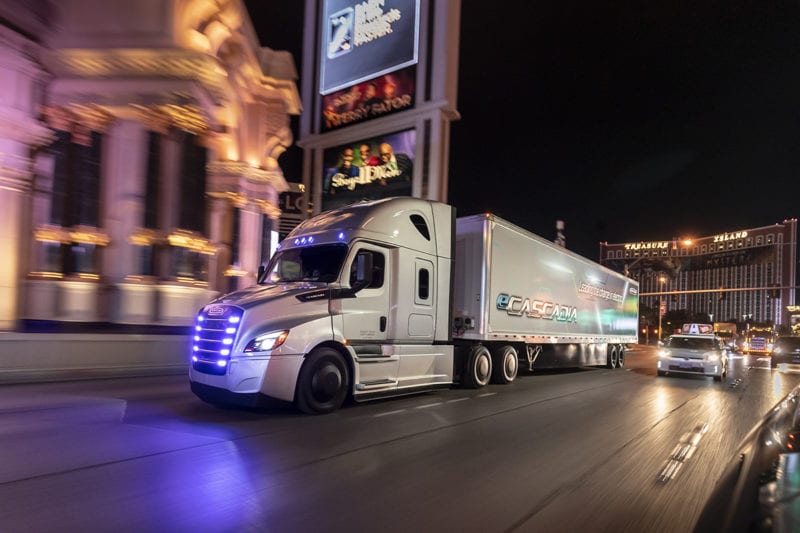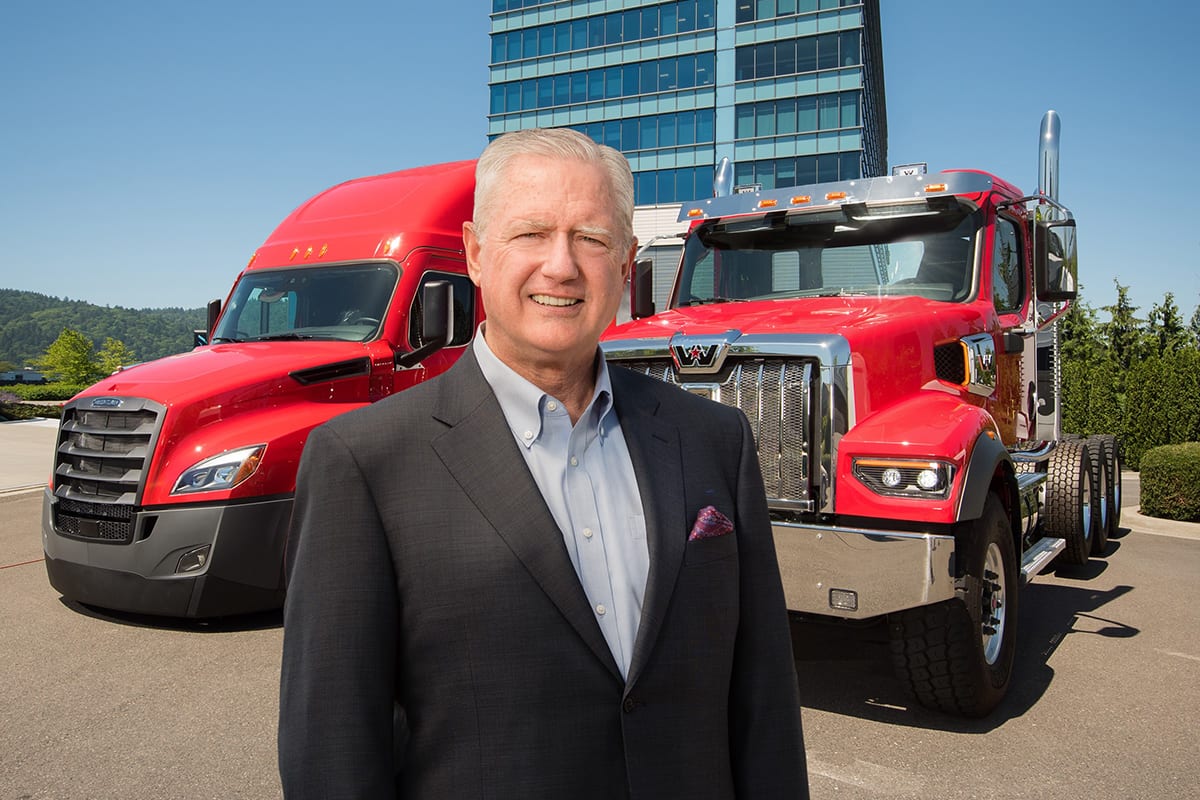An ACT News Executive Interview with John O’Leary, president and CEO of Daimler Trucks North America, on how the OEM is pushing through this past year and into the future of clean tech, a game plan that includes battery-electric trucks, fuel cells, charging infrastructure, and autonomous trucks.
This past April O’Leary took up the reigns of DTNA following the retirement of Roger Nielsen. Starting under the Freightliner brand in 2000, O’Leary soon took over DTNA’s school bus divison as the president and CEO of Thomas Built Buses. He then moved on to the role of senior vice president of the Aftermarket business, then CFO of DTNA in 2012. Since September 2020 John O’Leary has been the Chief Transformation Officer for Mercedes-Benz Trucks in Germany.
ACT News reached out to O’Leary to get his insight into the effects of the past year’s pandemic, the ongoing electrification evolution, and how DTNA sees its role in this and technological developments affecting the trucking industry.
ACT News: How has the COVID-19 pandemic affected the trucking industry and its recent shift towards more zero-emissions vehicles like the Freightliner eCascadia?
John O’Leary: The pandemic has really underscored the importance of our customer’s work, as well as the importance of our own industry.
It’s been a little over a year since stay-at-home orders were first enacted and social distancing requirements were put in place. Through it all, it was our customers and their drivers who kept the world moving. First by ensuring grocery stores were resupplied with food stuffs – and of course, toilet paper – but it became apparent very quickly that our trucks were at the center of more than just the resupply. Something like 40 ambulances are retired from service every day across the country, and even as our typical mega orders dipped, we saw a rush by ambulance builders to get the chassis they needed to ramp up and deploy more of them.
It was an eye opener for myself and our entire team to realize that our factories, our dealerships and our team was, quite literally, at the center for ‘all who keep the world moving,’ our global purpose statement. It really galvanized our team in those early days. And, later, to see those images of the first trucks – Freightliner trucks – leaving Pfizer and J&J facilities with vaccines as cargo, well, it was gratifying to know we played a small part in getting those to distribution sites.
Of the many things the pandemic has taught our industry, or even our world, it’s the importance of the men and women in the driver’s seat of our trucks.

Image: DTNA
ACT News: How will the current microchip shortage affect DTNA’s production timeline for its electric trucks?
John O’Leary: First, we’re already delivering our Thomas Built Buses all-electric Saf-T-Liner C2 Jouley school bus and have been fortunate not to experience any significant disruption there. In fact, we began deliveries in Q3 of last year and now have buses in Virginia, Massachusetts and – incredibly – Alaska, to name a few of the places they have been delivered. And we just announced that we delivered our 50th bus and have more on the way out to customers. School buses are a tremendously appropriate application for electrification – a vehicle that runs a dedicated, repeated route day after day and returns to a central depot every night, and every mid-day for that matter, to fully recharge for its next round of service.
Second, our all-electric walk-in van chassis, the Freightliner Custom Chassis Corp’s MT50e, will enter initial production late this year and remains on track. This is just another fantastic segment for electrification. Think of package cars doing home delivery, silently and with no tailpipe emissions – especially against the surge of ecommerce, we expect this to be a very popular vehicle with our customer.
Last and specific to the trucks you asked about, we don’t anticipate an impact to production as we plan to put the Freightliner eCascadia into series production in late ’22 and the medium-duty eM2 right after that in early ’23. We expect that any disruptions to the supply chain should be resolved by that time.
ACT News: What has been customers’ responses to the eCascadia and eM2?
John O’Leary: As you may know, we have roughly 40 pre-series production eCascadias and eM2s on the road today which more than 30 customers have piloted or are currently piloting. We started our Freightliner Electric Innovation Fleet in late 2018 and the Freightliner Customer Experience Fleet last June. To date, our customers have helped us accumulate more than 800,000 miles on the fleet and feedback from both customers and their drivers has been strong. We also opened the order boards for both of these trucks in early April and already have interested customers placing orders.
ACT News: How do you plan to support customers in terms of charging infrastructure?
John O’Leary: We plan to support our customers’ entire eMobility journey, which means not only providing the truck, but assisting with associated needs, like charging infrastructure. This is not new to us as our eConsulting team has already assisted nearly 30 customers in our pilot fleets with charging installation, and to a lesser degree with distributed energy resource services and grant applications. These eConsultants have truly become the in-house experts here at DTNA, as well as the most experienced group of consultants in our industry. In mid-April, we cemented their place within our brand structure and announced the creation of the Detroit consulting team.
At the same time, we launched the Detroit eFill line of chargers. When it comes to chargers, we are providing an array of options – from 30 kW to 400 kW to furnish an option for all of our customers, and even truck stop operators, to install chargers to suit their needs. And, all eFill chargers use the CCS-1 standard, the most prevalent type of charge connector, for interoperability with not only our trucks, but those of other, similarly egalitarian-minded truck OEMs and pass car manufacturers.
ACT News: In which sector do you believe electric trucks will have the biggest success in the short term? Long term?
John O’Leary: Deploying electric trucks is a journey the entire industry is just embarking on now here in the U.S. and that means growing through some of the early years of adoption. In the long term, we will need a public charging infrastructure comprised of ultrafast chargers, which we’re working on now with CharIN to create an Megawatt Charging System (MCS), and enable long-haul routes.
In the near term, we can provide our customers a dependable, reliable truck for return to hub type operations, where charging will be done on-site at their own facilities. Applications like school buses, final mile delivery, local/regional pick-up and delivery, drayage and food and beverage distribution are all well-suited to today’s battery technology.
Applications like school buses, final mile delivery, local/regional pick-up and delivery, drayage and food and beverage distribution are all well-suited to today’s battery technology.
ACT News: With electric trucks all the rage right now, how does this affect your other current alt fuel offerings and the development of other forms of clean tech like CNG?
John O’Leary: Really it comes down to ‘how do we provide the best of what the customer wants’ whether that be conventional technology – where we have a clear advantage in terms of efficiency and thus reduced emissions, or in terms of alternative propulsion choices.
CNG has been and is great at providing an immediate, reduced emissions output at the tailpipe, but the future, in the long run, will be electric. And we see that as both battery electric, as well as fuel cell electric. The two will be complementary technologies as we move forward with deployment of battery electric trucks imminent, as I mentioned.
CNG has been and is great at providing an immediate, reduced emissions output at the tailpipe, but the future, in the long run, will be electric.
ACT News: How does hydrogen fuel cell technology fit into the future of trucking and DTNA’s future plans?
John O’Leary: The future will undoubtedly be electric. And we see that as both battery electric as well as fuel cell electric. The two will be complementary technologies as we move forward with deployment of battery electric trucks imminent and fuel cells coming within the decade. Both are well suited to specific applications and will be able to coexist nicely.
ACT News: Autonomous vehicles are neck in neck in terms of interest by fleets when compared to electric and fuel cell trucks. Where do you see autonomous technology’s fit in the heavy-duty market and how it will affect trucking?
John O’Leary: We are still many years away from autonomous trucks comprising any significant percentage of total annual truck sales, however they will certainly benefit our industry – and society – in tremendous ways. Safety and efficiency gains are what I can see right out of the gate and we’re working with both a partner and our own subsidiary to integrate their software stack onto our trucks.
The technology will be a tremendous boon to roadway safety while also alleviating some of the driver shortage, and should alleviate the thought that drivers have to constantly be away from their families to make their living.
We are still many years away from autonomous trucks comprising any significant percentage of total annual truck sales, however they will certainly benefit our industry – and society – in tremendous ways.
ACT News: What lessons were learned from DTNA’s experiences with the Super Truck program and how were they translated into current production models?
John O’Leary: The intent of the first SuperTruck challenge was to increase freight-efficiency by a 50% goal, and we bested that with a 115% improvement over the baseline. It was an extremely valuable program that has benefited production-level models.
For instance, some of the improvements designed for our SuperTruck that found their way to production in Freightliner Cascadia include some of the general aerodynamics enhancements, the low ground clearance bumper, and the Stoneridge MirrorEye camera system. The latter of which we now offer a prewire for on our production trucks.
ACT News: What role will DTNA have in the third installment of this program and what do you hope to accomplish?
John O’Leary: We’ll participate, but beyond that I don’t want to preempt any of our plans — stay tuned for more about what we’ve done with Super Truck 2 first.


